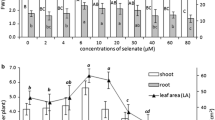Abstract
The wheat in hydroponics culture has been chosen as a model to study the dose-effect relationship of selenite with its growth. Five different morphological end points and 12 different biological and biochemical end points during different phases of growth of wheat seedling and seed germination have been measured and analyzed. A dose-effect relationship of selenite with the growth of wheat has been obtained from data analysis. The results shows that critical threshold for beneficial effect is about 1.0 mg Se/L, and the critical threshold for adverse effect is about 5.0 mg Se/L in hydroponics culture. From the result of product of lipid peroxidation, it is assumed that the role of selenium for plant is related to the oxy-radical reaction.
Similar content being viewed by others
References
G. Q. Yang, Studies of human selenium requirements in China, in G. F. Combs, O. A. Levander, J. E. Spallholz, and J. E. Oldfield, eds. Selenium in Biology and Medicine, 3th Symposium, Van Nostrand Reinhold, New York, pp. 589–618 (1987).
T. C. Broyer, O. C. Lee, and C. J. Asher, Selenium nutrition of green plants, effect of selenite supply on growth and selenium content of alfalfa and subterranean clover, Plant Physiol. 44, 1425–1428 (1966).
S. F. Trelease and H. M. Trelease, Selenium as a stimulating and possible essential element for certain plants, Science 15, 57–58 (1990).
M. H. Zhou, Influence of selenium on growth, root vigor and seed morphology of rice, Gui-Zhou Agri. Sci. (China) 15, 57–59 (1990).
Y. Xu, Z. J. Wang, and A. Peng, Effect of fulvic acid in environment on the uptake selenium of wheat, J. Ecol. (China) 16, 135–139 (1996).
Z. J. Wang, Y. Xu, and A. Peng, Influences of fulvic acid on bioavailability and toxicity of selenite for wheat seedling and growth, Biol. Trace Element Res. 55, 147–162 (1996).
P. L. Steponkus and F. O. Lanphear, Refinement of the triphenyl tetrazolium chloride method of determining cold injury, Plant Physiol. 42, 1423–1426 (1967).
G. L. Miller, Use of dinitro-salicylic acid reagent for determination of reducing sugar, Anal. Chem. 31, 426–428 (1959).
D. I. Arnon, Copper enzymes in isolated chloroplants polyphenoloxidase in Beet Vulgaris, Plant Physiol. 24, 1–4 (1949).
H. X. Liu, S. X. Zeng, Y. R. Wang, P. Li, D. F. Chen, and J. Y. Guo, Effect of low temperature on peroxidase activity of cucumbers seedling leaf with various ability of cold-resisting, Acta Plant Physiol. (China) 11, 48–57 (1985).
L. S. Bates, R. P. Waldren, and I. D. Teare, Rapid determination of free proline for water stress studies, Plant Soil 39, 205–214 (1973).
M. M. Bradford, A rapid and sensitive method for the quantities of microgram quantitative of protein utilizing the principle of protein dries binding, Anal. Biochem. 72, 248–251 (1976).
R. S. Dhindsa, P. D. Pamela, and T. A. Thorpe, Leaf senescence: correlated with increased levels of membrane permeability and lipid peroxidation and decrease levels of superoxide dismutase and catalase, J. Exp. Bot. 32, 93–95 (1981).
C. Z. Zhu, Determination of activity of peroxidase, Adv. Biochem. Biophys. (China) 6, 80–83 (1985).
B. J. Davis, Disc electrophoresis: Method and application to human serum protein, Ann. NY Acad. Sci. 121, 404–407 (1964).
Shanghai Plant Physiology Committee, Experimental Handbook of Plant Physiology, Shanghai Science and Technology Press, Shanghai, pp. 67–70 (1981).
J. Y. Zhou, B. H. Chen, and H. B. Xu, The dose-effect of selenium and active oxygen species, The Sixth International Symposium on Selenium in Biology and Medicine, Abstract Book, Beijing, p. 130 (1996).
K. X. Huang, Study on containing-selenium bio-macromolecule in plant, Ph.D. thesis, Hua-Zhong Polytechnical University, Wuhan, China, pp. 27–29 (1995).
Author information
Authors and Affiliations
Rights and permissions
About this article
Cite this article
Peng, A., Xu, Y., Liu, J.H. et al. Study on the dose-effect relationship of selenite with the growth of wheat. Biol Trace Elem Res 76, 175–181 (2000). https://doi.org/10.1385/BTER:76:2:175
Received:
Accepted:
Issue Date:
DOI: https://doi.org/10.1385/BTER:76:2:175




